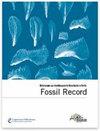下载PDF
{"title":"The largest specimen of Apateon and the life history pathway of neoteny in the Paleozoic temnospondyl family Branchiosauridae","authors":"Nadia B. Fröbisch, Rainer R. Schoch","doi":"10.1002/mmng.200800012","DOIUrl":null,"url":null,"abstract":"<p>Two distinct developmental trajectories, metamorphosis and neoteny (the retention of larval somatic features in adult animals), have been reported for the small gill-bearing branchiosaurids of the Late Carboniferous and Early Permian of central Europe. Based on a very large specimen of the species <i>Apateon caducus</i> (Ammon, 1889), anatomical features characteristic for the neotenic phenotype of branchiosaurids are described. Large neotenes lack changes that occur during a short phase of transformation into terrestrial adults (metamorphosis), such as ossification of the braincase and palatoquadrate and intercentra, further ossification of the girdles and formation of muscle attachment scars and processes on the limb bones. They also lack a distinct sculpturing of the dermal skull roofing elements with deep polygonal ridges and grooves. Instead, larval somatic features are retained including ossified branchial denticles indicative of open gill slits and accentuated larval-type sculpturing of the dermal skull roof. Large size, high degree of ossification as compared to the larvae, and the presence of uncinate processes on the ribs clearly demonstrate an adult ontogenetic stage. Neotenes remained in the aquatic environment throughout their life and were most likely not capable of effective terrestrial locomotion. The frequency distribution of the two phenotypes in modern salamander populations and the environmental cues that influence the development of them provide a comparative framework for the discussion of the evolution of the two life history pathways in branchiosaurids. (© 2009 WILEY-VCH Verlag GmbH & Co. KGaA, Weinheim)</p>","PeriodicalId":55147,"journal":{"name":"Fossil Record","volume":"12 1","pages":"83-90"},"PeriodicalIF":2.1000,"publicationDate":"2009-02-20","publicationTypes":"Journal Article","fieldsOfStudy":null,"isOpenAccess":false,"openAccessPdf":"https://sci-hub-pdf.com/10.1002/mmng.200800012","citationCount":"29","resultStr":null,"platform":"Semanticscholar","paperid":null,"PeriodicalName":"Fossil Record","FirstCategoryId":"89","ListUrlMain":"https://onlinelibrary.wiley.com/doi/10.1002/mmng.200800012","RegionNum":4,"RegionCategory":"地球科学","ArticlePicture":[],"TitleCN":null,"AbstractTextCN":null,"PMCID":null,"EPubDate":"","PubModel":"","JCR":"Q3","JCRName":"Earth and Planetary Sciences","Score":null,"Total":0}
引用次数: 29
引用
批量引用
Abstract
Two distinct developmental trajectories, metamorphosis and neoteny (the retention of larval somatic features in adult animals), have been reported for the small gill-bearing branchiosaurids of the Late Carboniferous and Early Permian of central Europe. Based on a very large specimen of the species Apateon caducus (Ammon, 1889), anatomical features characteristic for the neotenic phenotype of branchiosaurids are described. Large neotenes lack changes that occur during a short phase of transformation into terrestrial adults (metamorphosis), such as ossification of the braincase and palatoquadrate and intercentra, further ossification of the girdles and formation of muscle attachment scars and processes on the limb bones. They also lack a distinct sculpturing of the dermal skull roofing elements with deep polygonal ridges and grooves. Instead, larval somatic features are retained including ossified branchial denticles indicative of open gill slits and accentuated larval-type sculpturing of the dermal skull roof. Large size, high degree of ossification as compared to the larvae, and the presence of uncinate processes on the ribs clearly demonstrate an adult ontogenetic stage. Neotenes remained in the aquatic environment throughout their life and were most likely not capable of effective terrestrial locomotion. The frequency distribution of the two phenotypes in modern salamander populations and the environmental cues that influence the development of them provide a comparative framework for the discussion of the evolution of the two life history pathways in branchiosaurids. (© 2009 WILEY-VCH Verlag GmbH & Co. KGaA, Weinheim)
最大的Apateon标本及古生代鳃龙科幼崽的生活史路径
中欧晚石炭世和早二叠纪的小型带鳃的支龙类有两种不同的发育轨迹,变态和幼态(在成年动物中保留幼虫的体细胞特征)。基于一个非常大的物种标本Apateon caducus (Ammon, 1889),描述了branchiosaurids的新生表型的解剖学特征。大型幼龙缺乏在向陆生成虫转变的短阶段(变态)中发生的变化,如颅脑和腭方骨和中心间骨的骨化,腰带的进一步骨化以及肢体骨骼上肌肉附着疤痕和突起的形成。他们也缺乏一个明显的雕刻真皮头骨屋顶元素与深多边形脊和凹槽。相反,保留了幼虫的躯体特征,包括骨化的鳃齿,表明张开的鳃缝和突出的幼虫型真皮头骨顶部的雕刻。与幼虫相比,大的体型,高度的骨化,肋骨上钩状突起的存在清楚地表明了成虫的个体发生阶段。幼龙一生都生活在水生环境中,很可能无法有效地在陆地上运动。这两种表型在现代蝾螈种群中的频率分布以及影响它们发育的环境线索为讨论分支龙两种生活史途径的进化提供了一个比较框架。(©2009 WILEY-VCH Verlag GmbH &KGaA公司,Weinheim)
本文章由计算机程序翻译,如有差异,请以英文原文为准。


